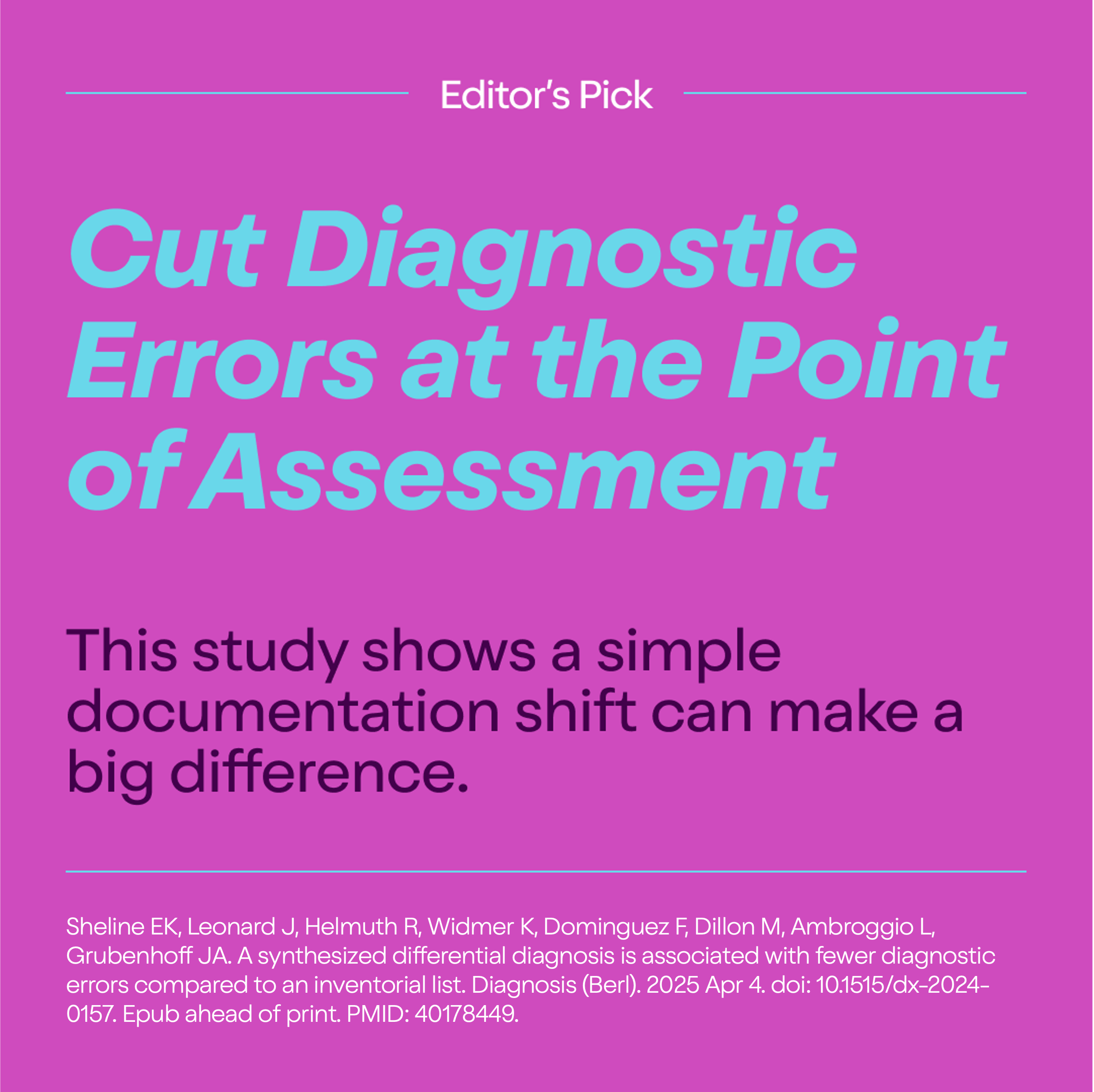Editor's Pick: Diagnostic Errors and Why DDx Reasoning Style Matters
“A synthesized differential diagnosis is associated with fewer diagnostic errors compared to an inventorial list”
Erica K. Sheline, Jan Leonard, Rebecca Helmuth, Kaitlin Widmer, Fidelity Dominguez, Mairead Dillon, Lilliam Ambroggio, and Joseph A. Grubenhoff
Diagnosis (subscription required)
April 4, 2025
Note: A subscription is required to access the full publication.
What's the point?
Getting to the right diagnosis is a clinician’s most important job. Unfortunately, most harmful diagnostic errors happen early: during the initial assessment when a patient first seeks care.
This study reviewed medical records for 884 pediatric emergency department (ED) patients who returned to the ED within 10 days after that first visit—a potential red flag that something went wrong. The researchers looked at how the doctors made their differential diagnosis (DDx) through either:
-
A “synthesized” DDx approach, which includes the reasoning for why a possible diagnosis would be likely or unlikely.
-
An “inventory” DDx approach, which is simply a laundry list of possible diagnoses without justification.
After using a validated tool to assess for diagnostic errors, the researchers paired 303 similar cases using either a synthesized or inventory approach. The error rate was 16.5% in synthesized DDx cases vs. 27.4% in inventory-style DDx cases. Patients whose clinicians used an inventory DDx had 1.79 times higher odds of experiencing a diagnostic error.
The Bottom Line: When clinicians justify their differential diagnoses—rather than listing possibilities without explanation—diagnostic errors are significantly less likely.
Why does this matter?
It’s really hard to find reasons why clinicians make diagnostic errors. This is a rare study that finds a clear, actionable difference in diagnostic error rates. A few takeaways:
-
A decent proportion of all pediatric “bounce-backs” to the hospital involved some diagnostic error; we should look more closely when patients return with similar symptoms.
-
A systematic and justified differential may help clinicians slow down and connect clinical information to the diagnosis they’re considering.
-
Electronic health records (EHR) and tools can also support clinicians in justifying and synthesizing their DDx.
Overall, a synthesized DDx approach offers a simple, actionable method to reduce the risk of diagnostic error at the individual clinician level.
Who does this impact?
Medical educators can use this study as evidence to support teaching a synthesized approach to DDx in clinical reasoning. Encourage learners not just to list possibilities, but to justify each item on the differential using the clinical data at hand—and to explain why certain diagnoses are being ruled out.
Clinicians, you can modify how you document the differential diagnosis—by including justification for or against each possibility—to potentially reduce diagnostic error, particularly in the ED. You also can consider using note templates or prompts to support this more structured, synthesized reasoning.
Patients and families: You have a right to be involved in the diagnostic process! Ask your provider what possible diagnoses they’re considering, and why. If your symptoms keep coming back or aren’t improving after treatment, it could mean the initial diagnosis missed the mark.
Quality improvement professionals can use tools like SaferDx to identify diagnostic errors in high-risk populations, such as how the researchers of this study assessed pediatric patients returning shortly after an ED visit. Use this approach to review bounce-back cases and uncover system-level patterns in diagnostic performance.
Healthcare system leaders and administrators can use these findings as evidence to restructure charting/clinical note templates at their institutions to support more synthesized diagnostic reasoning. Tools like the Revised IDEA Assessment Tool may help evaluate whether documentation changes are improving diagnostic quality.
About Editor's Picks
Curated by the UCSF CODEX team, each Editor’s Pick features a standout study or article that moves the conversation on diagnostic excellence forward. These pieces offer meaningful, patient-centered insights, use innovative approaches, and speak to the needs of patients, clinicians, researchers, and decision-makers alike. All are selected from respected journals or outlets for their rigor and real-world relevance.
View more Editor's Picks here.
